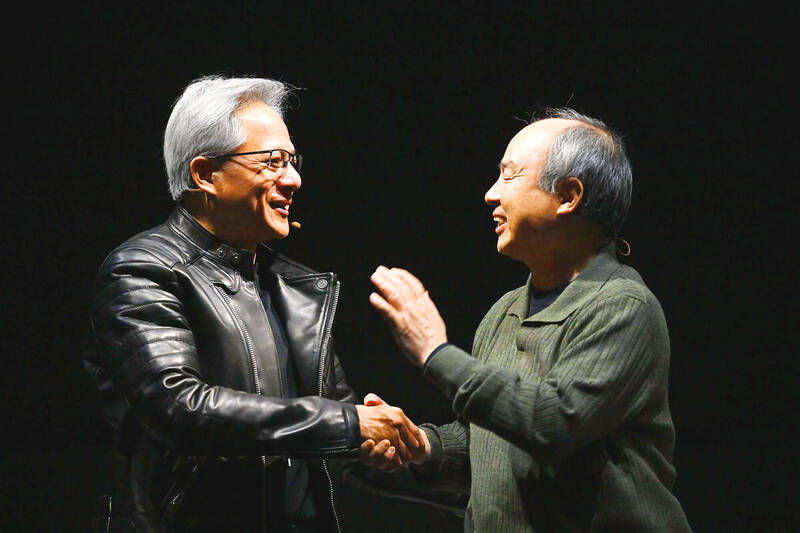Softbank Group Corp would be the first to build a supercomputer with chips using Nvidia Corp’s new Blackwell design, a demonstration of the Japanese company’s ambitions to catch up on artificial intelligence (AI).
The group’s telecom unit, Softbank Corp, plans to build Japan’s most powerful AI supercomputer to support local services, it said.
That computer would be based on Nvidia’s DGX B200 product, which combines computer processors with so-called AI accelerator chips.

Photo: Bloomberg
A follow-up effort will feature Grace Blackwell, a more advanced version, the company said.
The announcement indicates that Softbank Group, which until early 2019 owned 4.9 percent of Nvidia, has secured a favorable spot in line for the AI chips.
Softbank Group founder Masayoshi Son has said he is preparing to “swing for the fences” in AI bets.
The company on Tuesday reported a return to profitability on rising tech valuations.
Son joined Nvidia chief executive officer Jensen Huang (黃仁勳) on stage in Tokyo during Nvidia’s AI Summit yesterday.
When reminded of Softbank Group’s prior Nvidia stake — which would be worth about US$178 billion today — Son cringed and laughed, then wrapped Huang in a bear hug.
Nvidia has been crisscrossing the globe to host such events, promoting what it calls the new industrial revolution. Events in India and now Japan are aimed at broadening the deployment of AI systems to nation-based efforts and lessening Nvidia’s reliance on a few large US customers.
In addition to the new computer and the plan for a second, Softbank Group’s telecom unit would also use Nvidia gear to provide AI services over cellular networks. Traditional hardware, based on custom chips that are designed to maximize mobile data traffic, is not optimal for new AI services.
“What will result is an AI grid that runs across Japan,” Huang said, adding that this would change the communications network into an AI network.
New AI radio access networks, would be better-suited to remote robotics, autonomous vehicle support and powering other services, Huang said.
They would also require less electricity, he added.
The telecom unit would begin testing the network with partners Fujitsu Ltd and International Business Machines Corp’s Red Hat Inc.
“We are going to buy a lot of your chip,” Son told Huang.
Japan is on the cusp of change, said Son, who has often criticized both the country’s government and companies for their slowness in adopting new technologies.
This time, the Japanese government is not getting in the way of a buildout in AI and robotics, he said.
The Japanese government has allocated ¥4 trillion (US$26 billion) to bolster its domestic chip production capacity. That includes a moonshot project behind Rapidus Corp to build a state-of-the-art foundry from scratch to challenge Taiwan Semiconductor Manufacturing Co (台積電), which manufactures Nvidia chips. Japanese Prime Minister Shigeru Ishiba has also pledged more than US$65 billion of fresh support for the nation’s semiconductor and AI sectors.
“But they should encourage more,” Son told Huang. “As you say, this is the reset, this is the catch-up moment for this revolution. We can’t miss this time.”

JITTERS: Nexperia has a 20 percent market share for chips powering simpler features such as window controls, and changing supply chains could take years European carmakers are looking into ways to scratch components made with parts from China, spooked by deepening geopolitical spats playing out through chipmaker Nexperia BV and Beijing’s export controls on rare earths. To protect operations from trade ructions, several automakers are pushing major suppliers to find permanent alternatives to Chinese semiconductors, people familiar with the matter said. The industry is considering broader changes to its supply chain to adapt to shifting geopolitics, Europe’s main suppliers lobby CLEPA head Matthias Zink said. “We had some indications already — questions like: ‘How can you supply me without this dependency on China?’” Zink, who also

Taiwan Semiconductor Manufacturing Co (TSMC, 台積電) received about NT$147 billion (US$4.71 billion) in subsidies from the US, Japanese, German and Chinese governments over the past two years for its global expansion. Financial data compiled by the world’s largest contract chipmaker showed the company secured NT$4.77 billion in subsidies from the governments in the third quarter, bringing the total for the first three quarters of the year to about NT$71.9 billion. Along with the NT$75.16 billion in financial aid TSMC received last year, the chipmaker obtained NT$147 billion in subsidies in almost two years, the data showed. The subsidies received by its subsidiaries —

At least US$50 million for the freedom of an Emirati sheikh: That is the king’s ransom paid two weeks ago to militants linked to al-Qaeda who are pushing to topple the Malian government and impose Islamic law. Alongside a crippling fuel blockade, the Group for the Support of Islam and Muslims (JNIM) has made kidnapping wealthy foreigners for a ransom a pillar of its strategy of “economic jihad.” Its goal: Oust the junta, which has struggled to contain Mali’s decade-long insurgency since taking power following back-to-back coups in 2020 and 2021, by scaring away investors and paralyzing the west African country’s economy.

The number of Taiwanese working in the US rose to a record high of 137,000 last year, driven largely by Taiwan Semiconductor Manufacturing Co’s (TSMC, 台積電) rapid overseas expansion, according to government data released yesterday. A total of 666,000 Taiwanese nationals were employed abroad last year, an increase of 45,000 from 2023 and the highest level since the COVID-19 pandemic, data from the Directorate-General of Budget, Accounting and Statistics (DGBAS) showed. Overseas employment had steadily increased between 2009 and 2019, peaking at 739,000, before plunging to 319,000 in 2021 amid US-China trade tensions, global supply chain shifts, reshoring by Taiwanese companies and